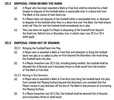By running off the line, clearly Elliott has played on whilst still out of bounds of the playing area. If this wqs in the field of paly, the umpire would have ceertainly called "play on".
This is not the first time we have seen this happen but the question remains, whenever a player does this, why isn't it called "play on" and therefore the boundary umpire blows the whistle to signal "out of bounds" ??





